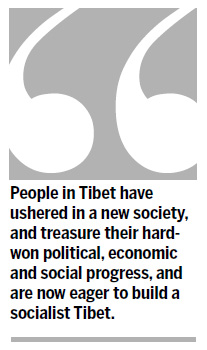Op-Ed Contributors
Come and see the real Tibet
Updated: 2011-03-28 08:01
By Yi Duo (China Daily)
|
|
March 28 is "Serfs Emancipation Day", a day celebrated by more than 2.9 million people of all ethnic groups in the Tibet autonomous region. On this day in 1959, a democratic reform was carried out, under the leadership of the Communist Party of China (CPC), which overthrew theocratic feudalism and freed millions of serfs and slaves, and heralded a new era in the history of the region.
But the Dalai Lama and his political group, the chief representatives of old Tibet's serf-owning class, have never ceased their attempts to split the motherland and undermine the region's progress and ethnic unity. They have been trying, unsuccessfully, to restore feudalism in Tibet.
The Dalai Lama and his supporters disregard history, distort facts and spare no efforts to glorify old Tibetan society, claiming that old Tibet was "more civilized" and a better place than today's Tibet. These are not only vain attempts to distort facts and international agreements, but also conceited denials of the remarkable progress that Tibet has made since 1959.
|
||||
In the old days, Tibet's agriculture and animal husbandry were extremely backward and completely at the mercy of the elements. There was no industry or means of transport in the modern sense of the term, nor was there a single highway.
Since the democratic reform, under the CPC Central Committee, the vigorous support and selfless assistance of other provinces (autonomous regions and municipalities) and the efforts of the people of all ethnic groups, Tibet has seen earth-shaking progress and written an unprecedented success story in many fields.
Tibet's local GDP soared from 174 million yuan ($26.5 million) in 1959 to 34.22 billion yuan in 2007, a 59-fold increase with an average annual growth of 8.9 percent at comparable prices. Since 1994, the local GDP has grown at an average annual rate of 13 percent, higher than the national average. Such a high pace of growth was beyond imagination in the Tibet of yore.
During the 11th Five-Year Plan (2006-2010), Tibet followed the development road with national and regional characteristics and expedited its rapid economic and social development, laying a solid foundation for building a moderately prosperous society.
Tibet's GDP nearly doubled from 2006 to 2010, reaching 50.75 billion yuan with an annual average growth rate of 12.4 percent. Investment in fixed assets totaled 165.6 billion yuan, 2.4 times more than the 10th Five-Year Plan (2001-2005) period, retail sales of consumer goods reached 67 billion yuan, and the local fiscal revenue touched 12.63 billion yuan.
Specials

Share your China stories!
Foreign readers are invited to share your China stories.

Fill dad's shoes
Daughter and son are beginning to take over the family business of making shoes.

Have you any wool?
The new stars of Chinese animation are edging out old childhood icons like Mickey Mouse and Hello Kitty.



